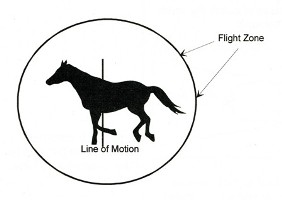Pat Comerford, Extension Horse Specialist, Penn State University; and Betsy Greene, Equine Extension Specialist, University of Vermont
Contents |
Flight Zone
One point to consider when approaching and working with your horse is its flight zone.
- Understanding the flight zone can reduce stress to the horse and help prevent accidents to both horse and handler. The flight zone is the horse’s “personal space”.

- The size of the flight zone depends primarily on the tameness or familiarity of the horse with the handler. With frequent handling, the flight zone decreases in size and may even disappear. A horse that is approached head-on has a larger flight zone than if it is approached from the side. A head-on approach by another horse or human is considered threatening.
You do not have the Flash plugin installed, which means you are missing out on great interactive content. Download Flash.
Horse’s Flight Zone and Defense
- Movement into the flight zone will cause the animal to move away. The edge of the flight zone can be determined by slowly walking up to the horse. The point at which the horse begins to move away is the edge of the flight zone. Recognizing and working at the edge of the flight zone can be very helpful when approaching or catching a loose horse, working in a round pen, longeing, working a horse in hand, etc.
- When working with a horse, there is a point-of-balance for moving the horse backward or forward. The point-of-balance is at the shoulder, perpendicular to the length of the body. If you want the horse to move backwards, start in front of the point-of-balance and move into the horse’s flight zone. If you want the horse to move forward, move into the horse’s space from behind the point-of-balance.
- If a handler enters the flight zone too deeply and quickly, the horse will either bolt and run away or turn back and run over the person. It is important to be aware of the flight zone and the horse’s response to the handler within and near the flight zone. This will help to ensure safety at all times for the handler.
Take A Learning Lesson
For more information about the horse’s flight zone, check out the learning lesson Horse Owner Survival.


